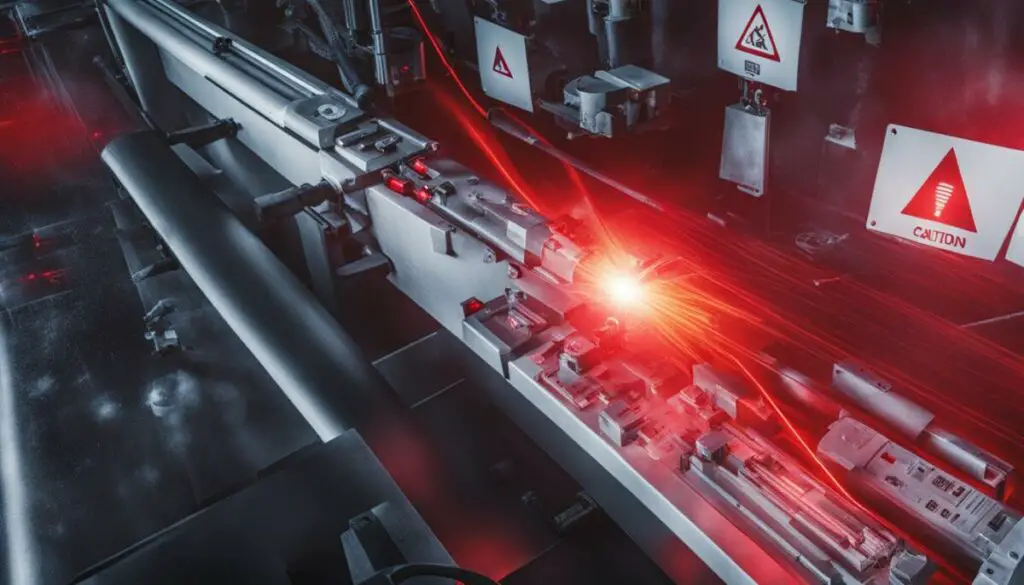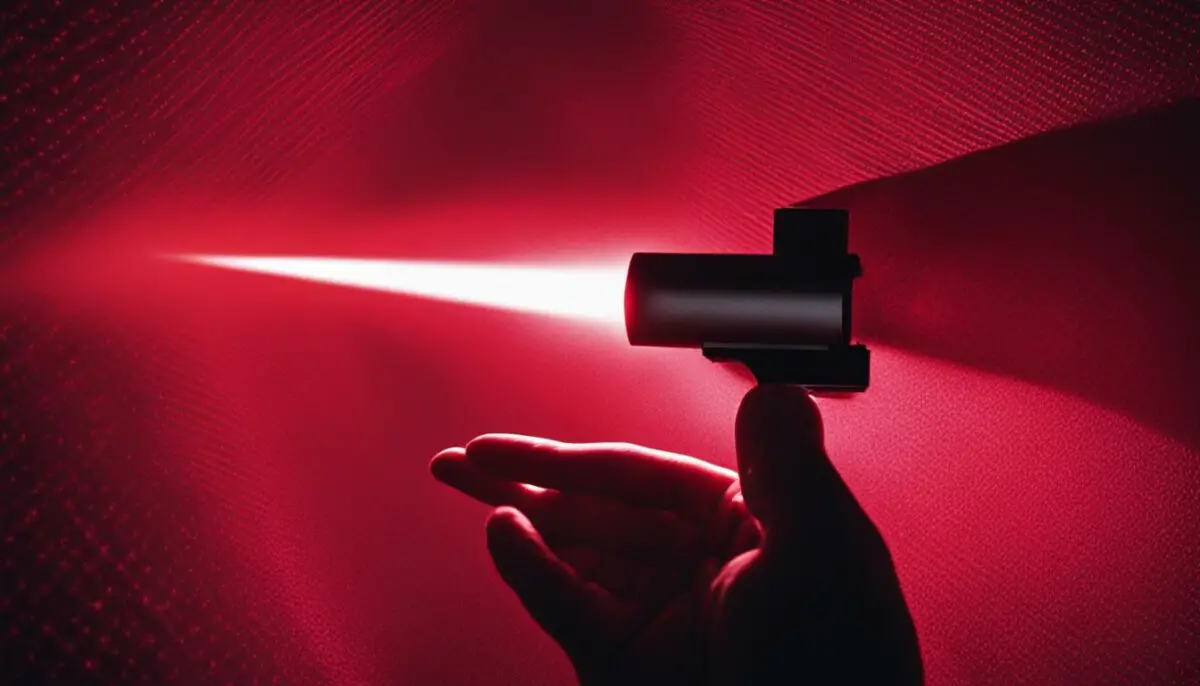Last Updated on 5 months by Francis
Welcome to our comprehensive guide on the topic of infrared lasers and their potential dangers. In this article, we will delve into the safety concerns associated with infrared lasers, providing you with valuable insights to help you understand the risks involved.
As technology continues to advance, the use of infrared lasers has become more prevalent. These lasers, with their powerful beams and wide range of applications, have raised questions about their safety and potential harm. It is essential to be well-informed about the dangers of infrared lasers to ensure their responsible and safe usage.
Throughout this guide, we will explore the hazards of laser light, focusing on the risks it poses to the eyes and skin. We will also discuss specific safety concerns related to infrared lasers, such as eye and skin injuries, as well as the indirect hazards of laser radiation. Additionally, we will cover the classification of laser devices and the confusion surrounding international laser safety criteria.
Contents
Key Takeaways:
- Infrared lasers can be hazardous to the eyes and skin due to their high optical intensities.
- Exposure to infrared lasers can cause thermal and photochemical damage to the eyes.
- Proper precautions, such as wearing protective eyewear, are necessary when handling infrared lasers.
- Infrared lasers can also cause skin injuries through thermal effects.
- Laser radiation can have indirect effects, such as incinerating materials and generating secondary radiation.
The Hazards of Laser Light
Laser beams can be hazardous, particularly for the eyes and skin, due to their high optical intensities. Even moderate intensities can cause serious permanent damage to the retina. The risks vary depending on the spectral region of the laser, with ultraviolet lasers causing corneal flash burns and infrared lasers potentially causing painful corneal injuries. Safe exposure limits are determined by factors such as intensity, wavelength, and duration of irradiation.
| Laser Type | Risk to Eyes | Risk to Skin |
|---|---|---|
| Ultraviolet | Corneal flash burns | Photochemical reactions, changes in pigmentation, erythema, and skin cancer |
| Infrared | Corneal injuries | Thermal effects, potential burns |
Exposure to infrared lasers can cause both thermal and photochemical damage to the eyes. The intensity of the laser on the retina is a crucial factor in determining the potential harm. Safe handling and precautions are necessary to protect against eye injuries, including wearing appropriate protective eyewear and following safe exposure limits.
Infrared lasers can also cause skin injuries, mainly through thermal effects. The penetration depth depends on the wavelength, with longer wavelengths causing more pain on the skin. Ultraviolet lasers can induce photochemical reactions, leading to changes in pigmentation, erythema, and even skin cancer. It is important to take precautions to avoid direct skin exposure and potential burns.
Eye Safety Concerns with Infrared Lasers
When it comes to infrared lasers, eye safety is a significant concern. The intense radiation emitted by these lasers can cause both thermal and photochemical damage to the eyes. The retina, in particular, is vulnerable to injury from the intensity of the laser beam. To ensure eye safety when handling infrared lasers, it is crucial to follow proper precautions and wear appropriate protective eyewear.
Safe exposure limits are determined by factors such as the intensity, wavelength, and duration of the laser beam. The longer the exposure and the higher the intensity, the greater the potential for harm. It is essential to be aware of these factors and adhere to recommended exposure limits to minimize the risk of eye injuries.
In addition to wearing protective eyewear, other precautions should be taken when working with infrared lasers. These include properly aligning the laser beam, ensuring it does not directly enter the eye, and avoiding looking directly into the laser beam. By following these precautions and guidelines, the potential health hazards associated with infrared lasers can be effectively mitigated.
Skin Safety Concerns with Infrared Lasers
In addition to the potential harm to the eyes, skin safety is also a significant concern when it comes to infrared lasers. These lasers can cause skin injuries primarily through thermal effects. The extent of damage depends on the wavelength, with longer wavelengths causing more pain on the skin. It’s important to take precautions to avoid direct skin exposure and potential burns.
According to research and safety guidelines, ultraviolet lasers can induce photochemical reactions, leading to changes in pigmentation, erythema, and even skin cancer. This highlights the importance of protective measures when working with infrared lasers. Proper protective clothing, including gloves and suitable clothing materials, should be worn to minimize the risk of skin damage.
One way to ensure skin safety is by implementing safe operating procedures and training programs for individuals who work with infrared lasers. These programs should cover the potential hazards associated with skin exposure and provide guidelines for selecting appropriate protective measures. By following these safety protocols, the potential harm caused by infrared lasers to the skin can be significantly reduced.
| Thermal Effects | Photochemical Reactions |
|---|---|
| Can cause skin injuries | Changes in pigmentation |
| Longer wavelengths cause more pain | Erythema |
| Direct skin exposure can lead to burns | Skin cancer |
Indirect Hazards of Laser Radiation
While the direct hazards of laser radiation are well-known, it is important to also consider the indirect hazards associated with laser material processing. These hazards can pose significant risks in industries that rely on laser technology for various applications. Understanding these indirect hazards is crucial for implementing appropriate safety measures and minimizing potential harm.
One of the main indirect hazards of laser radiation is the potential for incinerating materials and causing fires. When a laser interacts with certain materials, such as flammable substances or combustible gases, it can ignite them, leading to fires that can quickly spread and cause extensive damage. This risk is especially relevant in industries that involve laser cutting, welding, or engraving.
Another indirect hazard is the release of poisonous fumes or hot droplets of molten material. When certain materials are exposed to laser radiation, they can release toxic gases or create splatters of hot molten material. These fumes and droplets can be harmful to both human health and the environment, necessitating proper ventilation systems and protective equipment in laser processing facilities.
Furthermore, laser radiation can generate secondary radiation such as ultraviolet light or X-rays. This secondary radiation can pose additional health risks to workers if proper shielding measures are not in place. Shielding materials and techniques must be employed to minimize the exposure to harmful secondary radiation and ensure the safety of personnel working with laser systems.
To summarize, the indirect hazards of laser radiation in laser material processing industries include the risk of fires, the release of poisonous fumes or hot droplets of molten material, and the generation of secondary radiation. These hazards underline the importance of implementing comprehensive safety protocols and ensuring that workers are adequately protected from both the direct and indirect risks associated with laser radiation.
Other Hazards Associated with Laser Systems
Laser systems can pose various hazards beyond the direct effects of laser radiation. It is important to be aware of these additional risks to ensure the safety of individuals working with or near laser systems. Some of the key hazards associated with laser systems include:
- Hazards of Laser Power Supplies: Laser power supplies can pose electrical hazards due to high-voltage components. Care must be taken to ensure proper grounding and insulation to prevent electrical accidents. Additionally, the risk of electric shock or burns can be minimized by following safe handling procedures and using appropriate personal protective equipment.
- Hazards of Laser Chemicals: Certain laser systems, such as those using laser dyes, may involve the use of hazardous chemicals. These chemicals can pose risks such as toxicity, flammability, and reactivity. It is essential to handle and store these chemicals safely, following appropriate handling procedures and using suitable containment systems.
Furthermore, laser systems can also present other risks, including the potential for glass tubes to explode or implode during handling. This risk can be mitigated by following proper handling procedures and using appropriate protective measures, such as safety shields and gloves. It is vital to familiarize yourself with the specific hazards associated with the laser system you are working with and take necessary precautions to prevent accidents and injuries.
Image source: https://seowriting.ai/32_6.png
| Hazards | Risks |
|---|---|
| Hazards of Laser Power Supplies | Risk of electrical accidents and electric shock |
| Hazards of Laser Chemicals | Risk of exposure to toxic, flammable, or reactive substances |
| Risk of Glass Tube Explosions | Potential for glass tubes in laser systems to explode or implode |
Particularly Hazardous Situations

When working with infrared lasers, there are certain situations that pose higher risks and require specific precautions. Understanding these particularly hazardous situations can help ensure the safe use of these lasers.
High-Risk Laser Beams: Near-Infrared and Ultraviolet
Near-infrared laser beams are especially hazardous due to their ability to focus directly on the retina without triggering the blink reflex. This means that even a momentary exposure can potentially cause significant damage to the eyes. Precautions should always be taken when working with near-infrared lasers, including wearing appropriate protective eyewear and minimizing direct exposure.
Ultraviolet lasers also pose risks to both the eyes and skin. UV radiation can lead to corneal flash burns and cause photochemical reactions in the skin, resulting in skin damage and potential long-term effects. It is crucial to take extra precautions, such as using protective barriers and following strict safety protocols, when working with UV lasers.
Pulsed Laser Sources: High Peak Powers
Some infrared lasers generate pulses with extremely high peak powers. These pulses can cause immediate and severe eye damage if proper precautions are not taken. It is essential to use appropriate protective eyewear specifically designed for high-powered pulsed lasers to prevent any potential harm.
Open Laser Setups: Beam Hazard Prevention
In open laser setups, there is a risk of hazardous laser beams leaving the setup and unintentionally hitting someone’s eye. This can lead to serious eye injuries. Therefore, it is crucial to implement safety measures such as beam enclosures, beam stops, and interlocks to prevent the escape of laser beams and ensure the safety of all individuals in the vicinity.
By being aware of these particularly hazardous situations and taking necessary precautions, the risks associated with using infrared lasers can be effectively minimized. It is important to always prioritize safety and follow established guidelines and procedures to ensure the well-being of both operators and those around them.
Safety Classes for Laser Devices

When it comes to the safety of laser devices, it is essential to understand the different safety classes that they fall into. Laser devices are categorized into various classes based on their potential hazards, with each class having specific guidelines and exposure limits. By understanding these safety classes, users can ensure safe handling and usage of laser devices, including infrared lasers.
Laser Safety Classes
The most commonly used classification system for laser devices is the one defined by the International Electrotechnical Commission (IEC). This system categorizes laser devices into the following classes:
- Class 1: These lasers are considered safe under normal operating conditions and pose no hazards to the eyes or skin. Examples include laser printers and barcode scanners.
- Class 2: These lasers emit visible light in the wavelength range of 400 to 700 nanometers and can cause temporary eye discomfort or flash blindness if directly viewed for an extended period. However, the natural blink reflex protects against any long-term damage. Examples include laser pointers and presentation remotes.
- Class 3R: These lasers are considered relatively safe but may pose a risk if viewed directly for an extended period. While the risk of eye damage is low, precautions should still be taken. Examples include some laser pointers and small handheld lasers.
- Class 3B: These lasers can cause immediate eye damage if directly viewed or if the beam is focused on the eye. Laser safety precautions, such as wearing appropriate protective eyewear, are crucial when working with Class 3B lasers.
- Class 4: These lasers are the most hazardous and can cause severe eye and skin damage, as well as pose a fire hazard. They require strict safety measures, specialized training, and protective measures such as barriers, interlocks, and warning signs.
It is important to note that the classification of a laser device depends on factors such as laser power, beam quality, wavelength, and accessibility to hazardous areas. Users should always refer to the manufacturer’s specifications and guidelines for accurate classification and safety information.
By following the safety guidelines and exposure limits set for each laser safety class, individuals can properly handle and use infrared lasers without compromising their own safety or the safety of others.
Note: The image above illustrates the different safety classes for laser devices.
Laser Beam Hazards and Classification
When it comes to laser safety, understanding the potential hazards associated with laser beams is crucial. Laser beams have the potential to cause burns, chemical reactions, and tissue damage to exposed eyes and skin. The severity of the damage depends on factors such as laser power, beam quality, and wavelength. To ensure safe usage, laser devices, including laser pointers, are classified into different classes based on their potential harm.
Class 3B and Class 4 lasers are considered the most hazardous, with the potential to cause significant eye damage. These lasers should be handled with extreme caution and appropriate protective measures, such as wearing laser safety goggles, should be taken when working with them. On the other hand, Class 1 and Class 2 lasers are considered safe for normal usage, posing minimal risks to the eyes and skin.
It is important to note that the classification of laser beams is not only based on their potential to cause harm but also on other factors such as accessibility to hazardous areas. Each safety class has specific guidelines and exposure limits that should be followed to ensure safe handling and usage. By adhering to these guidelines and taking necessary precautions, the risks associated with laser beam exposure can be effectively mitigated.
Table: Laser Classification
| Class | Potential Hazards |
|---|---|
| Class 1 | No known hazards |
| Class 2 | Low-power lasers that pose minimal risks |
| Class 3A | Low to moderate risks; caution advised |
| Class 3B | Moderate to high risks; potential for eye damage |
| Class 4 | High risks; potential for eye and skin damage |
Understanding the classification and potential hazards associated with laser beams is essential for promoting laser safety in various industries and applications. Whether you are working with lasers in research, medical, or industrial settings, it is crucial to prioritize safety and follow recommended guidelines to protect yourself and others from the potential harm of laser radiation.
Non-beam Hazards Associated with Laser Work
While laser beams pose significant risks to eye and skin safety, there are also non-beam hazards that need to be considered when working with lasers. These non-beam hazards include electrical hazards, chemical hazards, and mechanical hazards that can jeopardize the safety of individuals and the workspace.
Electrical Hazards
Working with laser systems often involves high-voltage power supplies, which can present electrical hazards. It is crucial to follow proper electrical safety procedures to avoid electric shock or other electrical accidents. This includes ensuring that equipment is properly grounded, using insulated tools, and following safety protocols when working with power supplies.
Chemical Hazards
Laser work may involve the use of hazardous chemicals, such as laser dyes or cleaning solvents. It is important to handle these chemicals with caution and in accordance with safety guidelines. This includes wearing appropriate personal protective equipment (PPE), storing chemicals properly, and following proper disposal procedures to minimize the risk of chemical exposure or accidents.
Mechanical Hazards
Handling laser equipment carries the risk of mechanical hazards, such as glass tubes exploding or imploding. It is essential to handle laser components with care, ensuring proper installation and maintenance of laser systems. Following safety protocols when handling laser equipment can help mitigate the risk of mechanical accidents and injuries.
Additionally, fire hazards, x-ray generation, and electromagnetic interference can also be associated with laser work. It is crucial to implement safety measures and adhere to relevant standards and guidelines to mitigate these non-beam hazards effectively. By being aware of these hazards and taking the necessary precautions, individuals can ensure a safe working environment when working with lasers.
Confusion in International Laser Safety Criteria
The subject of laser safety involves international organizations such as the World Health Organization (WHO) and the International Committee for Non-ionizing Radiation Protection (ICNIRP), as well as national standards bodies. While there is generally good agreement in laser safety criteria, there are differences between European and American approaches. These differences can lead to confusion in the classification of laser pointers and other laser products. It is important to understand the specific safety criteria and regulations in your region.
In the European Union (EU), laser products are regulated under the European Standard EN 60825, which defines the safety requirements for laser equipment. The EU categorizes laser products into four classes: Class 1, Class 1M, Class 2, and Class 3R. These classes are determined based on the potential risk to eye and skin exposure. Class 1 and Class 2 lasers are considered safe for normal usage, while Class 3R lasers may cause harm if viewed directly. Class 1M lasers are safe for normal usage but may pose a risk if viewed through magnifying optics.
In the United States, laser safety criteria are set by the Food and Drug Administration (FDA) under the Code of Federal Regulations (CFR) Title 21. The FDA regulates laser products based on their intended use and potential hazards. The FDA classifies lasers into four main classes: Class 1, Class 2, Class 3R, and Class 4. Class 3R lasers are considered relatively safe but can still cause harm if viewed directly. Class 4 lasers are the most hazardous and can cause severe eye and skin injuries.
| EU Laser Safety Classification | US Laser Safety Classification |
|---|---|
| Class 1 | Class 1 |
| Class 1M | Class 2 |
| Class 2 | Class 3R |
| Class 3R | Class 4 |
| N/A | Class 3B |
“The differences in laser safety criteria between Europe and the United States can lead to confusion, especially for manufacturers and distributors of laser products. It is essential to ensure compliance with the specific regulations in each region to avoid misclassification and potential safety hazards.” – Laser Safety Expert
Conclusion
After examining the potential risks and safety concerns associated with infrared lasers, it is clear that they can be dangerous if not handled or used correctly. The hazards of laser light, particularly for the eyes and skin, are well-documented. Even moderate intensities can cause serious permanent damage, making it crucial to follow safe exposure limits.
Eye safety concerns with infrared lasers are of particular importance, as the eyes are highly sensitive to laser radiation. Thermal and photochemical damage can occur, highlighting the need for safe handling and precautions. Wearing appropriate protective eyewear and adhering to safe exposure limits are essential for protecting against eye injuries.
In addition to eye safety, skin safety concerns should not be overlooked. Infrared lasers can cause skin injuries through thermal effects, and certain lasers can induce photochemical reactions. Precautions must be taken to avoid direct skin exposure and potential burns.
Overall, by following safety guidelines, understanding laser device classifications, and being aware of non-beam hazards associated with laser work, the risks associated with infrared lasers can be effectively mitigated. It is imperative to prioritize safety measures to ensure the protection of both individuals and the surrounding environment.
FAQ
Are infrared lasers dangerous?
Infrared lasers can be dangerous if not handled or used correctly. They have the potential to cause harm to the eyes and skin.
What are the hazards of laser light?
Laser light can cause serious permanent damage to the eyes and skin due to its high optical intensities. The risks vary depending on the spectral region of the laser.
What are the eye safety concerns with infrared lasers?
Infrared lasers can cause both thermal and photochemical damage to the eyes. Safe handling and precautions, such as wearing protective eyewear, are necessary to protect against eye injuries.
What are the skin safety concerns with infrared lasers?
Infrared lasers can cause skin injuries through thermal effects. Precautions should be taken to avoid direct skin exposure and potential burns.
What are the indirect hazards of laser radiation?
Laser radiation can have indirect effects, including incinerating materials, causing fires, and generating secondary radiation such as ultraviolet light or X-rays.
What are the other hazards associated with laser systems?
Laser systems can pose hazards such as high electric voltages, hazardous chemicals, and the risk of glass tubes exploding or imploding.
Are there particularly hazardous situations when using infrared lasers?
Near-infrared laser beams and pulsed laser sources pose higher risks and require specific precautions. Ultraviolet lasers also pose risks to both the eyes and skin.
What are the safety classes for laser devices?
Laser devices are categorized into different safety classes based on their potential hazards. Class 1 lasers are considered the least dangerous, while Class 4 lasers are the most hazardous.
What are the hazards associated with laser beams and their classification?
Laser beams can pose hazards to exposed eyes and skin, causing burns and tissue damage. Laser pointers are classified into different classes based on their potential harm.
What are the non-beam hazards associated with laser work?
Non-beam hazards include electrical hazards, exposure to hazardous chemicals, mechanical hazards, fire hazards, x-ray generation, and electromagnetic interference.
Is there confusion in international laser safety criteria?
There are differences between European and American approaches to laser safety criteria, which can lead to confusion in the classification of laser pointers and other laser products.
Is there a conclusion to this guide?
The guide does not have a conclusion section. However, by following appropriate safety measures and guidelines, the risks associated with infrared lasers can be effectively mitigated.


.jpg)






